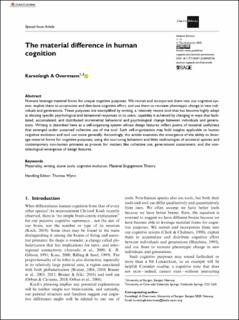| dc.contributor.author | Overmann, Karenleigh Anne | |
| dc.date.accessioned | 2021-08-04T11:07:37Z | |
| dc.date.available | 2021-08-04T11:07:37Z | |
| dc.date.created | 2020-09-16T23:37:04Z | |
| dc.date.issued | 2020 | |
| dc.identifier.issn | 1059-7123 | |
| dc.identifier.uri | https://hdl.handle.net/11250/2766177 | |
| dc.description.abstract | Humans leverage material forms for unique cognitive purposes: We recruit and incorporate them into our cognitive system, exploit them to accumulate and distribute cognitive effort, and use them to recreate phenotypic change in new individuals and generations. These purposes are exemplified by writing, a relatively recent tool that has become highly adept at eliciting specific psychological and behavioral responses in its users, capability it achieved by changing in ways that facilitated, accumulated, and distributed incremental behavioral and psychological change between individuals and generations. Writing is described here as a self-organizing system whose design features reflect points of maximal usefulness that emerged under sustained collective use of the tool. Such self-organization may hold insights applicable to human cognitive evolution and tool use more generally. Accordingly, this article examines the emergence of the ability to leverage material forms for cognitive purposes, using the tool-using behaviors and lithic technologies of ancestral species and contemporary non-human primates as proxies for matters like collective use, generational sustainment, and the non-teleological emergence of design features. | en_US |
| dc.language.iso | eng | en_US |
| dc.publisher | SAGE Publications | en_US |
| dc.rights | Navngivelse 4.0 Internasjonal | * |
| dc.rights.uri | http://creativecommons.org/licenses/by/4.0/deed.no | * |
| dc.title | The material difference in human cognition | en_US |
| dc.type | Journal article | en_US |
| dc.type | Peer reviewed | en_US |
| dc.description.version | publishedVersion | en_US |
| dc.rights.holder | Copyright The Author(s) 2020 | en_US |
| cristin.ispublished | true | |
| cristin.fulltext | original | |
| cristin.qualitycode | 1 | |
| dc.identifier.doi | 10.1177/1059712320930738 | |
| dc.identifier.cristin | 1830662 | |
| dc.source.journal | Adaptive Behavior | en_US |
| dc.source.pagenumber | 123-135 | en_US |
| dc.identifier.citation | Adaptive Behavior. 2020, 29 (2), 123-135. | en_US |
| dc.source.volume | 29 | en_US |
| dc.source.issue | 2 | en_US |

